In the Yoshida-Nihonmatsu burial cluster, only Burial No. 8 has haniwa, ceramic funerary sculptures. Numerous fragmented pieces of haniwa appeared in the fill of the eastern and southern ditches, and in both ditches, normal cylindrical haniwa and cylindrical haniwa with open tops were found. Representational haniwa, however, only appeared in the southern ditch. In Kyoto, the number of kofun which has been recognised as associated with haniwa is rather low. Thus, these haniwa tell us that there was the local leader whose burial mound was constructed here.
| HOME | Exhibition Top | CESCHI | CESCHI(Faculty) | Kyoto University |
| ⇒ Prev (Jomon-Yayoi) | ⇒ Next (Modern) |
| Burial decorated with Haniwa | |
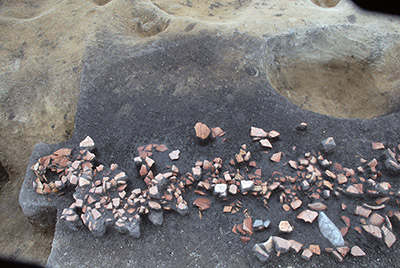
|
Age |
The end of 5th c. (Middle Kofun Period) |
|
| Location | |
Yoshida-South Campus |
|
| Caption | |
|
|
|
| ⇒ Return to Top | |
| Double-ditched burial | |
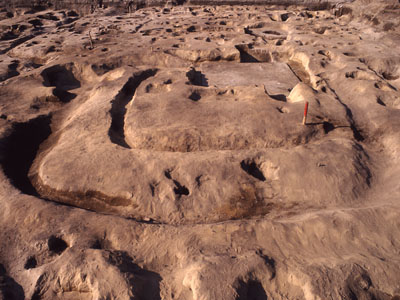
|
Age |
5th-6th c. (Middle Kofun Period) |
|
| Location | |
Yoshida-South Campus |
|
| Caption | |
|
A double-ditched square burial mound (kofun), measuring 10-13m each side. Despite the truncation by another grave construction of the medieval age, the main burial facility at the centre remained its base. Dedicated pottery of the Sue wares is dated to around 500 AD. The traces of five other burial mounds of the same shape have been excavated around this feature, leading to call this area the "Yoshida-Nihonmatsu" kofun cluster. |
|
| ⇒ Return to Top | |
| Pit-dwelling | |
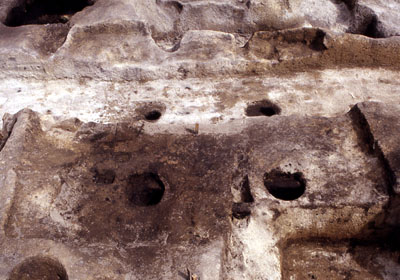
|
Age |
Mid 8th c. (Nara Period) |
|
| Location | |
Main Campus |
|
| Caption | |
|
A small pit-dwelling of a squared shape, measuring 3.2-3.3m each side with the depth of 0.3m, and having four upright-post holes inside. This dwelling was rebuilt to extend from the rectangular shape of 2.8m by 3.0m, revealed by re-flooring. Before the extension, there was a hearth at the middle of the western half and a gully projecting from the centre outwards to the south. |
|
| ⇒ Return to Top | |
| Salt-making fireplace | |
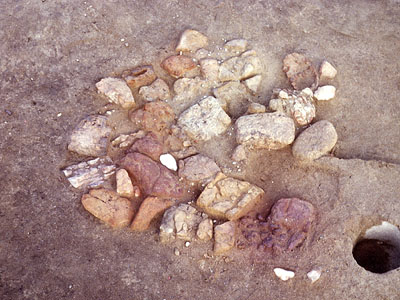
|
Age |
Late 8th c. (Nara Period) |
|
| Location | |
The Seto Marine Biological Laboratory |
|
| Caption | |
|
A stone-paved fireplace for salt-making, measuring 1.5m by 1.4m. A pit jammed with pottery debris close to this fireplace was mostly composed of fragments from a large number of the evaporating jars which took a slender cylindrical body with a pointed base. These features lead to regard this site as representative of ancient salt-workshops in the southern coast are of the Kinki district. |
|
| ⇒ Return to Top | |
| Casting pit | |
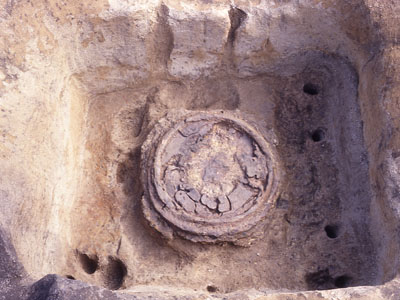
|
Age |
9th-10th c. (Middle Heian Period) |
|
| Location | |
Yoshida-South Campus |
|
| Caption | |
|
A large pit of a square shape measuring 2.5m each side with the depth of 1m, having dug for the manufacture of a large Buddhist bell. At the bottom of this pit, the base mould of fired clay, showing that a casted bell measuring around 1m in diameter, remained in situ. The fill of this pit contained a number of fragmented pieces of moulds and a furnace. The evidence for casting large bells here indicates that there might well have been Buddhist temples in the neighbourhood. |
|
| ⇒ Return to Top | |
| Chambered dedicates | |
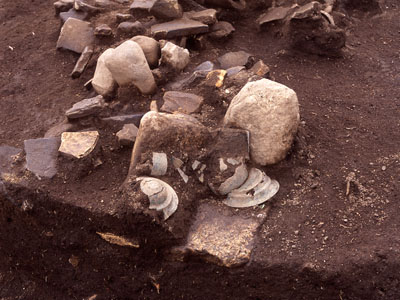
|
Age |
Mid 12th c. (Late Heian period) |
|
| Location | |
Yoshida-South Campus |
|
| Caption | |
|
A stone chamber for the dedicated transcription of a Buddhist scripture. Later activities of the medieval age disturbed the chamber as well as an inner bronze container for the transcription. Inside the pedestal part of the container, 13cm in diameter, were more than 150 glass beads. The main body of the container consists of four modules, which had been usually made during the middle of 12th century and had been popular in the Kyushu district, 500km to the west of Kyoto. |
|
| ⇒ Return to Top | |
| Cremation monument | |
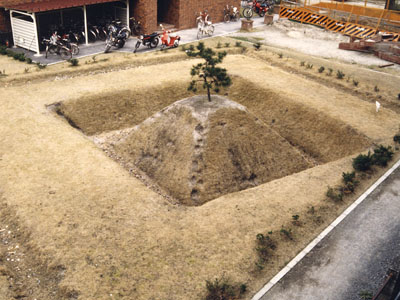
|
Age |
Around 1200AD (the beginning of the Medieval) |
|
| Location | |
North Campus |
|
| Caption | |
|
An earthen monument for remembering cremations. There actually remain quite a few graves of the ancient Emperors in this Kitashirakawa area. The pyramid-shaped mound was constructed in the regular-squared pit with the side of 15m. Its flattened top seems to have had a pine tree planted as a landmark, according to some historical documents. This photo shows the present reconstruction at the locale. |
|
| ⇒ Return to Top | |
| Remain of residence | |
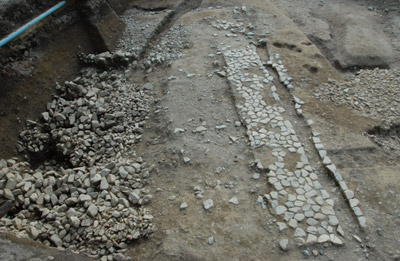
|
Age |
13th c. (Kamakura Period) |
|
| Location | |
West Campus |
|
| Caption | |
|
Stone pavement with rain gutter, of 1.4m in width, surrounding the square-shaped building of side 11.8m. |
|
| ⇒ Return to Top | |
| Forge | |
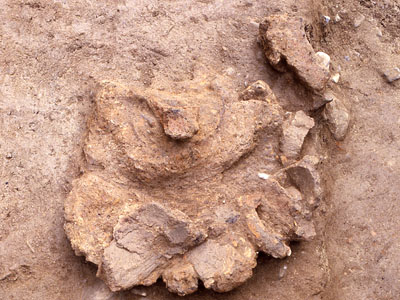
|
Age |
Mid 13th c. (Early Kamakura Period) |
|
| Location | |
Faculty of Medicine Campus |
|
| Caption | |
|
Casting remains for the manufacture of a Buddhist iron bell. Only the inner mould measuring 30cm in diameter stayed in situ, though surrounded by fragments of the outer mould. They do not seem to have been set up in a pit, but on the ground. The engraved motif of fragmented outer mould and the size of the rim of a bell lead together to remember the iron bell of the same period preserved in the famous Koryu-ji Temple in the western side of Kyoto City. |
|
| ⇒ Return to Top | |
| Grave | |
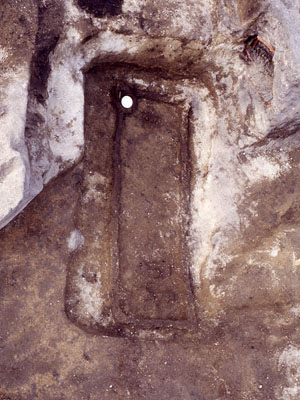
|
Age |
13th c. (Early Kamakura Period) |
|
| Location | |
Main Campus |
|
| Caption | |
|
A grave with the trace of a wooden coffin set on its bottom, suggested by the distribution of iron nails and decayed wooden fragments. The dead body, in the coffin measuring 1.8m by 0.6m with the thickness of 15mm, must have been laid with her/his head to the north, which is indicated by the location of a possible grave good at the northwest corner in the coffin; a complete bowl of white porcelain imported from China. |
|
| ⇒ Return to Top | |
| Well filled with Pottery | |
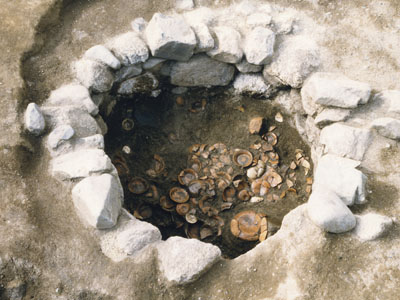
|
Age |
Mid 14th c. (Early Muromachi Period) |
|
| Location | |
Faculty of Medicine Campus |
|
| Caption | |
|
A well consisting of piled-up stones of a circular plan on the squared frame of planks. From the fill appeared a volume of debris originated from about 850 individual pottery in its number. More than 99% of them are of the Haji ware, possibly used in frequently-held ceremonial activities. |
|
| ⇒ Return to Top | |
| ⇒ Prev (Jomon-Yayoi) | ⇒ Next (Modern) |
| HOME | Exhibition Top | CESCHI | CESCHI(Faculty) | Kyoto University |